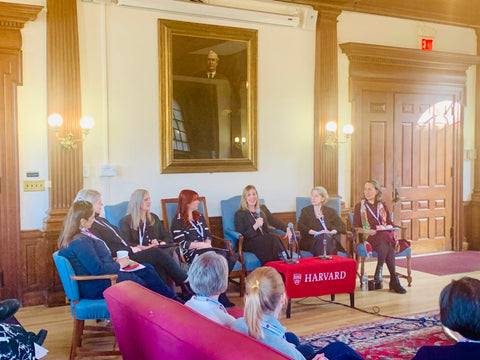Fashion has always been about expression and expressing power. During this unprecedented time of reflection on the balance of power between women and men, taking a closer look at the role fashion today plays in helping empower or oppress women adds a complex layer of questions.
Does it matter who is ‘telling’ us to wear what? Government, religious codes, our mothers and friends, or media? As swimwear designers in an industry that still idolizes scantily clad young women lying in repose on a deserted beach, we’re definitely sharpening our focus on the role we play in how women view their own agency.

We had an opportunity to discuss these hot-button topics on February 8th at the Global Women’s Empowerment Panel at Harvard. Alongside distinguished curators from New York’s Cooper-Hewitt Museum, Toronto’s Bata Shoe Museum and academics who study the history of women’s fashion and footwear, we took a shot at what the role of fashion actually means in society. Here’s what Loop Swim Co-founder Heather Kaye had to say.
“Is women’s fashion key to their freedom, social, political, and economic positions in the societies in which they live?”
The short answer is yes – if you live in an unequal society – which most of us do. When I ask my daughters what they think we’ll all be wearing in a future, they answer ‘comfy athleisure’, which fills me with dread, but in the bigger picture I hope they’re right.
It’s my working theory that the greater the emphasis on women’s fashion in a society – whether dictated or cultural – the more likely it is that you will find gender inequality. From government-mandated hijabs to young women in barely-there clothing, societies that place great import on how women and girls dress are more likely to lag behind in equal rights, equal pay, equal access to education, opportunities and autonomous power across genders.
From Shanghai to Sweden, in communities in which men and women are more equal citizens, they are also more equal in their love of fashion. Many young men in Shanghai (I’m careful here to say not China as a whole) are totally into fashion, in more or less equal proportion to young women which makes it a more equal playing field for everyone. Fashion returns to the dimension of self-expression that isn’t all about gaining power through emphasizing one’s sexual assets.
“Does feeling empowered through fashion translate into actual empowerment?”
This is the question we should all be asking. For all the time and money we spend on fashion, make-up and self-care, are we gaining real power, the power to make systemic changes, lead and influence others? If you look at statistics of the number of women in C-Suite positions in Fortune 500 companies (25%), you might be compelled to think no. But in most countries, we are heading in the right direction in terms of representation – though we will get there faster in sneakers than high heels (sales of which have been tanking since 2016).
Our goal at Loop Swim is to work towards an equal society, where everyone can contribute their gifts without discrimination or false limitations. Looking forward to that time, we might consider that in a society where there is greater equality, there is less of a need to obtain power through sexualized fashion because there are now more options available to women seeking power. Like just being incredibly awesome at what you do!
So where does that leave us as swimwear designers? What’s the right amount of sexy? We have customers who want to dive off cliffs, swim triathlons, paddleboard or surf – and for these fierce ladies we aim for top-shelf quality construction and designs that allow full freedom of movement. For those who want to relax on the beach or play in the surf with their little ones and still feel fabulous, we definitely have a range of bodies that offer a spectrum of less to more coverage – it should be up to you.
Ultimately, fashion is used as a means to identify with your tribe, and to receive or deflect attention.
There’s a wide spectrum of attention we each seek, in a wide spectrum of settings – and we want to offer our customer only positive attention for choosing to wear a sustainable brand designed for her.
“The nearly $3 trillion dollar global garment industry employs over 70 million people, 80% of which are women. How does the conversation of exploitation or empowerment of women apply to the women who make our clothing?”
The rise of fast fashion in particular has forever changed our relationship with and access to fashion, especially for women. Experimenting with cutting edge, disposable clothing at Walmart prices has brought with it a glut of options, but also exploitation of labor, resources and vast waste. Fast fashion targeting millennial and Gen Z young women has, until recently, peddled the tightest, tiniest fit possible – which when you consider that fabric is around 75% of the cost of most garments, equates to bigger margins for the industry.
The question I always ask myself before I buy something is: who is benefitting from or being exploited by my purchase? It’s impossible to discuss empowerment without looking at the money trail – if you are buying a $5 t-shirt, it’s almost certain that it was made by a woman in unsafe conditions, paying the true cost of the garment – along with our environment. For me, the exploitation of labor and our natural resources must be part of any conversation about fashion and women.
In the 20 years I’ve been a fashion designer, we’ve thrown away over 250 million pieces of unwanted clothing, with most of it going to landfill and contributing to increased levels of methane in our environment. Given that women and girls make up the majority of the world’s poor and according to the UN, are 14 times more likely to die in climate change disasters, the ramifications of fashion have evolved into something far more complex than high heels.
Connecting the dots between fashion, labor exploitation and the environment led my business partner and I to leave corporate fashion and start our own company with female empowerment, social and environmental sustainability at the core.
We started with eco-friendly apparel, then went a step further by switching to a category born to be circular: swimwear. Swimwear is made from polyester or nylon and so is a perfect candidate for using recycled inputs. Our company’s name is Loop Swim, which highlights our commitment to using recycled plastic bottles as our input and keeping our products out of the waste stream by being able to recycle them at end of life.
In addition to working closely with our retail partners, we’re helping facilitate the conversation on female empowerment, social and environmental sustainability with the factories and suppliers who make our swimwear, fellow designers, global companies, students and educators.
As we explore the themes of fashion and women’s freedom, oppression, exploitation, and empowerment, it is our view that the status of fashion is an important indicator of both the equality of women and a society’s commitment to sustainability.
“Is the future of fashion female? What will the industry look like in 10 years?”
It’s my prediction that the increasing pressures of an aging planet, necessitating more women to enter the work force, limited resources, and globalization of information will bring about a convergence in fashion in which it is both more artistic and appreciated – and also less important to social status.
We’ll have the combination technology of machine-made bespoke clothing, alongside sharing-economy closets. In other words, we will own less. The over-abundance of fast fashion and bloggers is already sapping our interest and bandwidth, swinging the pendulum closer to functional fashion. When this happens, I believe fashion will become less of a factor in women’s freedom, social, political, and economic position in society.
Truly artisan textiles and rare craft techniques will become prized and taught once more, but for our daily wear we will aim for function and gravitate towards the sharing economy model.
Fashion has a huge opportunity to change the narrative in support of women’s empowerment and lead the way for female power to become normalized and accepted. Despite being an industry dominated by women, only 14% of major fashion brands have a female CEO. As consumer, we need to vote with our wallets to support companies who support women – and remember that designers, inventors and creators have a great deal of power to bring us garments, products, spaces, tools that reflect a more equal society.




